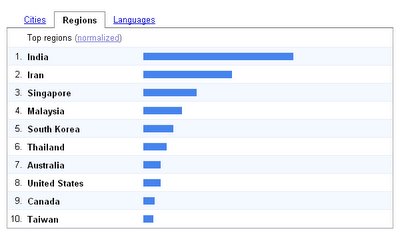Googling for nanotechnology

Who is googling the world wide web for nanotechnologies?
This is a question that I put to Google Trends. When I tapped in the word "nanotechnology" into Google Trends during the afternoon of 8th August 2006. I was surprised by the answer. The answer that Google Trends threw out was India - it was not China, Europe, South Korea, US or Japan. What is more, people in India are googling for online nanotechnology content at a level that significantly exceeds any other nations.
Google Trend also indicates that the top language in which "nanotechnology" is searched for is Korean and not English. So India and the rest of the world must be searching South Korean websites for nano content more than sites from other regions and nations?
 This is not to say that today India is a leading player in the nano field. As it happens, India is a late starter when it comes to nanosciences and nanotechnologies and still needs to build critical mass. India started its Nano Science and Technology Initiative just five years ago, during 2001, and has invested just around $24 million to date.
This is not to say that today India is a leading player in the nano field. As it happens, India is a late starter when it comes to nanosciences and nanotechnologies and still needs to build critical mass. India started its Nano Science and Technology Initiative just five years ago, during 2001, and has invested just around $24 million to date. What it does indicate is the increasing inner passion of individuals studying and/or working in India to strengthen their nation's global economic position through high-tech R&D and not just services and information technology.
An article published recently during June 2006 by the Science & Development Network "Preparing for take-off: Indian nanotechnology" says:
".... Brij Mohan Arora, a materials scientist at the Tata Institute of Fundamental Research in Mumbai points out that, overall, India does not have many achievements to showcase yet. "Much of it has been small table top research, but nevertheless it has created an awareness about techniques," he says.
If India wants to catch up with the best of the world's nanoscience researchers, and apply the technology to developing world issues — such as energy, water and health care — it seems that far greater investment is needed.
Fortunately for India, it is one of the few countries whose leader is pushing to improve funding for the sector. President A. P. J. Abdul Kalam, a former scientist in the space and defence sectors, was one of the first to point out that the country's nanotechnology research was sub-optimal.
In April 2004, Kalam organised a meeting of nanoscience experts to devise a national mission plan. Its recommendations include spending US$22 million each year for the next five years on five new national facilities specialising in complimentary areas of nanotechnology and ten 'mini centres' across the country. These centres would each receive US$5 million, and would focus on one or two areas of nanoscience and technology.
Overall, the experts recommended that US$200 million be spent on nanotechnology over a five-year period. India's finance ministry has now cleared these funds for use in 2006-2011. From later this year, the new national mission will oversee activities currently under the Nano Science and Technology Initiative.... "
Setting aside nanotechnology for a moment, a survey conducted by INSEAD and Booz Allen Hamilton, indicates that R&D is moving east. It suggestions that by the end of 2007, India and China will account for over 30% of global R&D staff, up from 19% during 2004.
Shak Gohir
Business & Programme Manager
Labels: Internet, Nanotechnology


0 Comments:
Post a Comment
<< Home